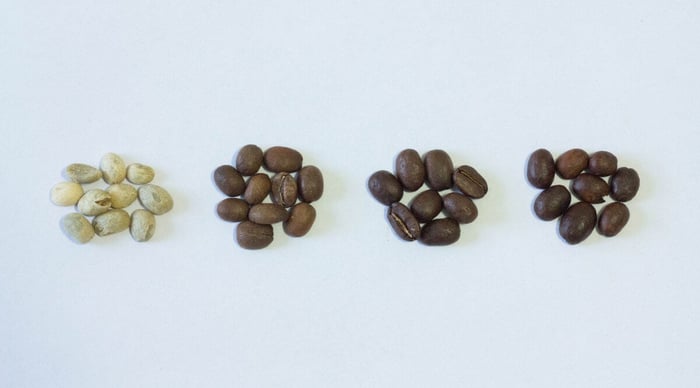Your Cart is Empty

Darker roasts have long dominated the coffee market; however, light roast coffee is coming into its own. Because of the complex flavor profiles, coffee connoisseurs gravitate towards light roast coffee beans.
Once coffee cherries, which contain coffee beans, have been harvested, they are processed and dried. Drying coffee beans preserves them to last longer in storage and transport. Then coffee beans must go through the roasting process.
Coffee roasters apply heat via roasting machines to batches of green coffee beans, which causes chemical reactions within the beans. These reactions result in the release of various aromas and flavors.
There are 3 primary roast levels — light roast, medium roast, and dark roast.
What is a light roast? Light roasts are roasted at slightly lower temperatures (350-400 degrees Fahrenheit) for shorter periods. Experienced coffee roasters look and listen for what’s called the “first crack” in the coffee beans to signal that a light roast has been achieved.
How do I know if my coffee is a light roast? Light roast coffee beans have a few hallmarks:
Medium roast coffee is roasted at about 410-430 degrees Fahrenheit until just before the second crack appears. It will have a rich brown color. Oils begin to surface, giving beans a slight shine. Medium roasts can have floral or chocolate undertones.
Dark roast coffee roasts at about 440-465 degrees Fahrenheit until the second crack appears. It will have a deep brown color and a shiny appearance. Also, dark roast beans will be the most porous and slightly larger. Dark roasts can have nutty or chocolate-tasting notes and have lower acidity.
Which roast is the strongest? Caffeine levels hardly differ among roasts. A common misconception is that lighter roast coffees have a higher caffeine content as the caffeine hasn’t had a chance to cook out. This is not the case.
Though flavors can differ based on how coffee is brewed, light roasts should have a lighter, brighter taste overall. Fruity and floral notes characterize a light roast cup of coffee. While medium and dark roasts have more of a sharp aftertaste, a light roast will hardly have one.
A bag of coffee contains more than just the brand name and logo these days. When looking for quality beans that will deliver on flavor, it’s best to know how to read your coffee’s label.
Search for fresh roasted coffee, meaning coffee that has been roasted recently. The closer you purchase your coffee to the roast date, the more flavorful the beans will be. You typically want to brew your coffee within two weeks of the roast date.
Tip: if you store your beans in a sealed container (read: not the bag it came in) in a dry, temperate environment, your beans should remain fresh longer.
Check to see if flavor notes are listed. For example, a typical description for medium roast beans would be milk chocolate, nutty, and brown sugar. For light roast coffee, look for mellow, fruity, or floral flavor notes.
Origin also plays a significant role in coffee taste. Coffee plants (the most sought-after being Arabica coffee beans) tend to thrive in the temperate, high altitude regions (shade-grown if possible) that make up the Bean Belt.
The following are major coffee countries and what their coffee is known for
Believe it or not, pesticides can affect the flavor of coffee. If you’re looking for delicious coffee without additives such as GMOs, consider trying USDA-certified organic light roast or organic coffee in general.
Single-origin coffee is in increasingly high demand. Single-origin means coffee beans came from the same crop, farm, and country. These coffee beans tend to be roasted in small batches so that consistency of the flavor profiles remains intact.
Many coffee enthusiasts prefer whole bean coffee to ground coffee.
Grinding whole coffee beans in a grinder directly before brewing (regardless of brewing method) usually equates to more flavorful coffee. Even so, ground coffee, when stored properly, can also produce flavorful coffee.
With the advent of third wave coffee, baristas and coffee lovers alike are paying more attention to coffee grade. Ideally, you want to see specialty grade or premium grade somewhere on the label, as these grades are given to the highest quality coffee beans available.
Because roasting is considered an art, coffee companies cultivate their own roasting techniques to roast truly unique batches of coffee beans.
It would be worth your time to familiarize yourself with light roast coffee brands, what their roasting processes entail, and the flavors they’re known for.
Also, be sure to check if a brand is categorized as fair trade. If so, this means the coffee company made sure the farmers received fair wages for their work.
Though there are 3 primary roasts (light, medium, and dark), each contains several subtler roasts. Let’s distinguish some of the varieties under the light roast banner.
While breakfast blend is usually a lighter roast coffee, sometimes it can be categorized as a medium roast. Because of its milder taste, it’s been dubbed the perfect morning coffee.
This is only slightly lighter than medium roast.
Blond roast coffee, also called blonde espresso, was popularized by Starbucks. Like most light roasts, it has a bright, caramelly taste.
It’s tempting to assume that cinnamon roast tastes like cinnamon spice. Cinnamon actually refers to the color of the beans instead. This roast can have a sour or even grassy taste to it.
White coffee inherits its name from the white beans that make it. White coffee typically acts as a base for espresso drinks as its flavor isn’t very distinctive on its own.
Golden roast coffee is considered the lightest and smoothest roast of coffee available.
What is thebest light roast coffee to buy? We may be a little biased, but our vote is Golden Ratio! Gold coffee is ideal if you’re looking to ditch the bitterness and acidity of other roasts.
Give Golden Ratio a whirl and experience the brighter flavors for yourself!